Archaeologists in Israel have made a groundbreaking discovery that marks a first for the region: a spectacular Roman-era marble sarcophagus depicting a mythological scene of a drinking contest between Dionysus, the god of wine, and Heracles, the legendary hero. The 1,700-year-old burial coffin was unearthed during excavations conducted by the Israel Antiquities Authority at the initiative of the Caesarea Development Corporation.
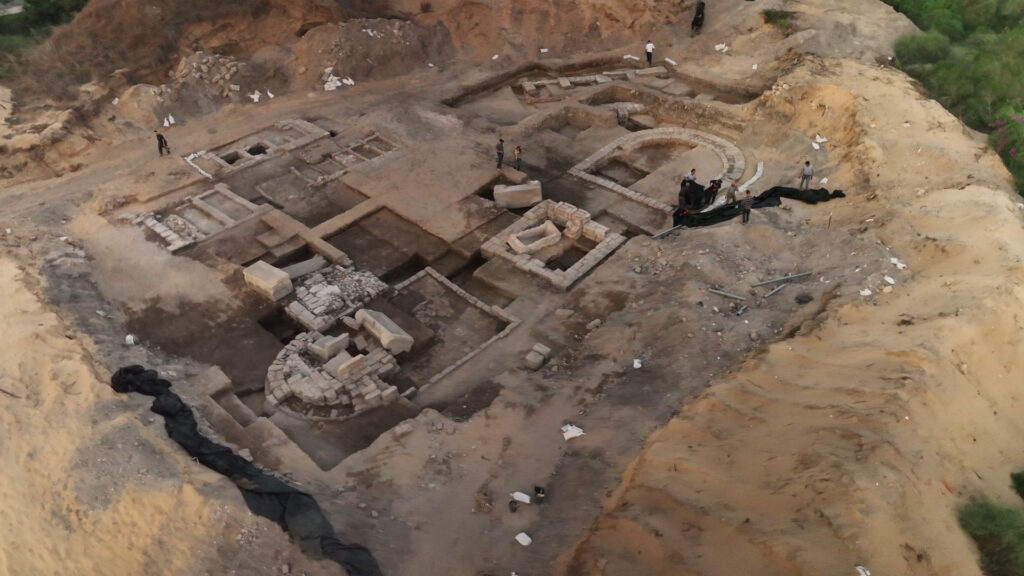
The Caesarea excavation – aerial view. Photo: Emil Aladjem, Israel Antiquities Authority
This remarkable find represents the first time such a scene has been discovered on a burial coffin in the region, making it a unique addition to Israel’s archaeological treasures.
A Movie-Like Discovery
The moment of discovery was nothing short of cinematic, according to the excavation team leaders. “It was like a scene out of a movie,” describe Nohar Shahar and Shani Amit, Israel Antiquities Authority archaeologists who led the excavation. “We began removing the soft, light sand of the dune, when suddenly the tip of a marble object popped up. The entire excavation team stood around excitedly, and as we cleared more sand, we couldn’t believe what we were seeing – parts of a sarcophagus, upon which figures were carved: gods, animals, and trees. Each uncovered fragment was more impressive than the one before.”
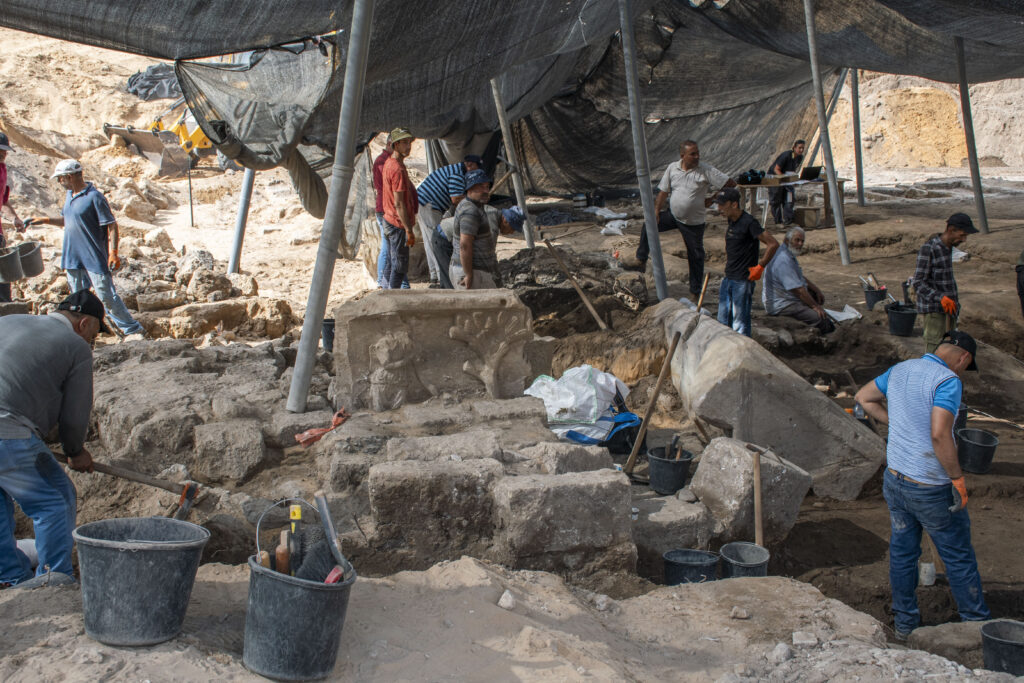
The Caesarea excavation of the Israel Antiquities Authority. Photo: Yoli Schwartz, Israel Antiquities Authority
The excavation’s climactic moment came in the final hour of work. “In fact, in the very last hour of the excavation came the climax – an entire intact side of the sarcophagus, which was buried in the sand, was uncovered, which portrays the scene of Hercules lying on a lion skin, holding a cup in his hand,” the archaeologists recalled.
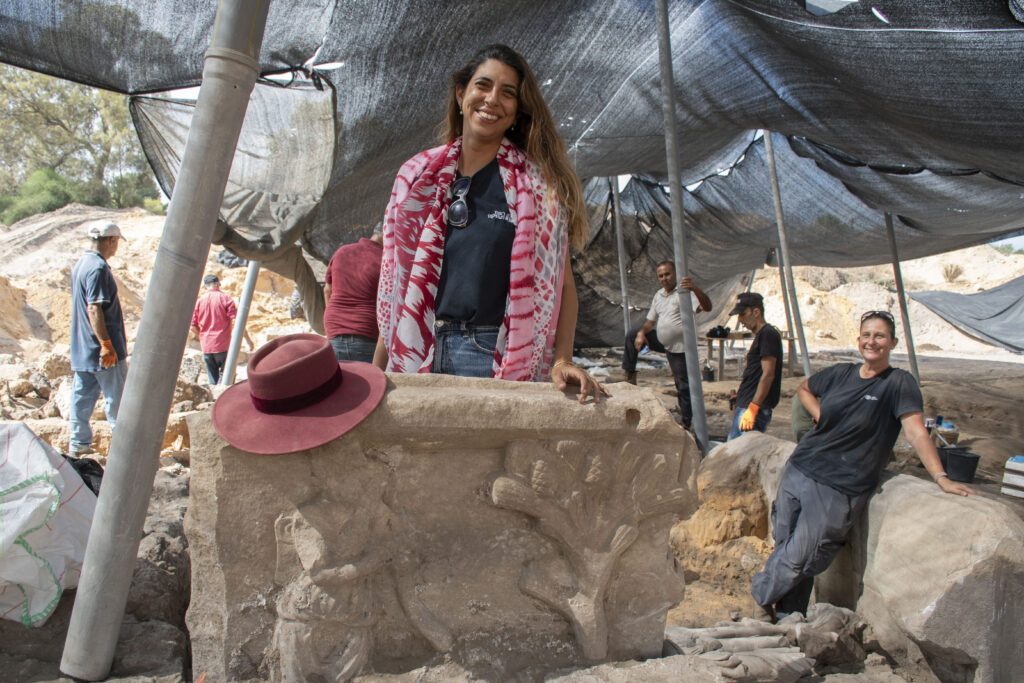
From left to right – Archaeologists Nohar Shahar and Shani Amit from the Israel Antiquities Authority. Photo: Yoli Schwartz, Israel Antiquities Authority
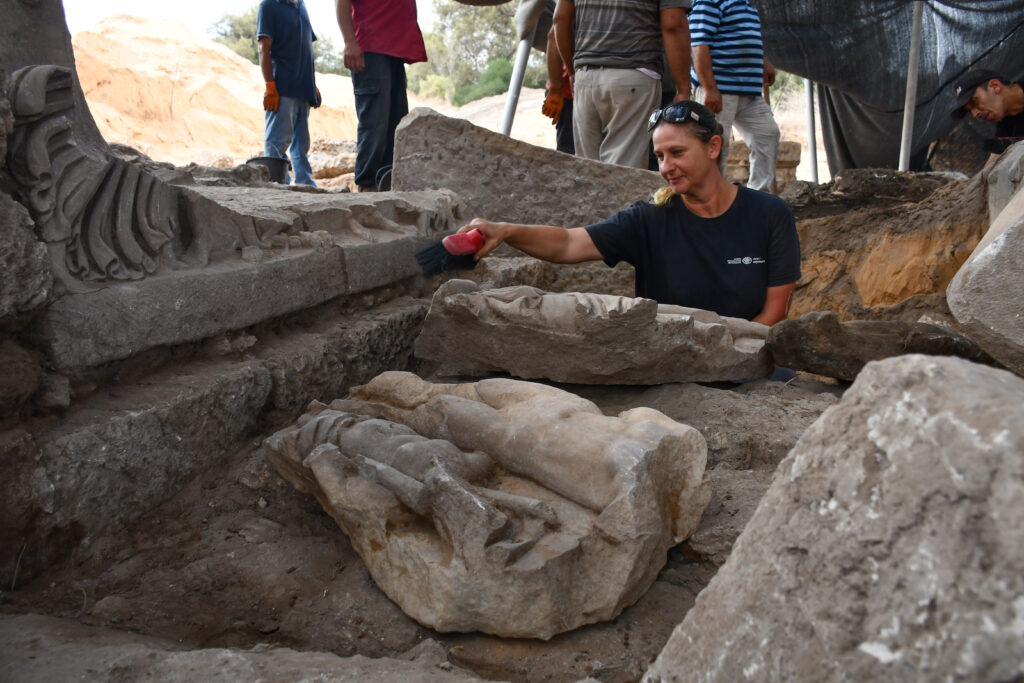
The marble sarcophagus was found broken. Photo: Yoli Schwartz, Israel Antiquities Authority
Meticulous Restoration Reveals Intricate Details
Following its discovery, the fragmented sarcophagus was carefully transported to the Israel Antiquities Authority’s conservation team for restoration. The painstaking work was carried out by conservators Solomon Gavriel, Ilya Armanovsky, and Gadmo Vajpo, working alongside architect Ido Rosental. Their expertise in restoring, cleaning, and assembling the pieces allowed the full magnificence of the ancient artwork to be revealed.
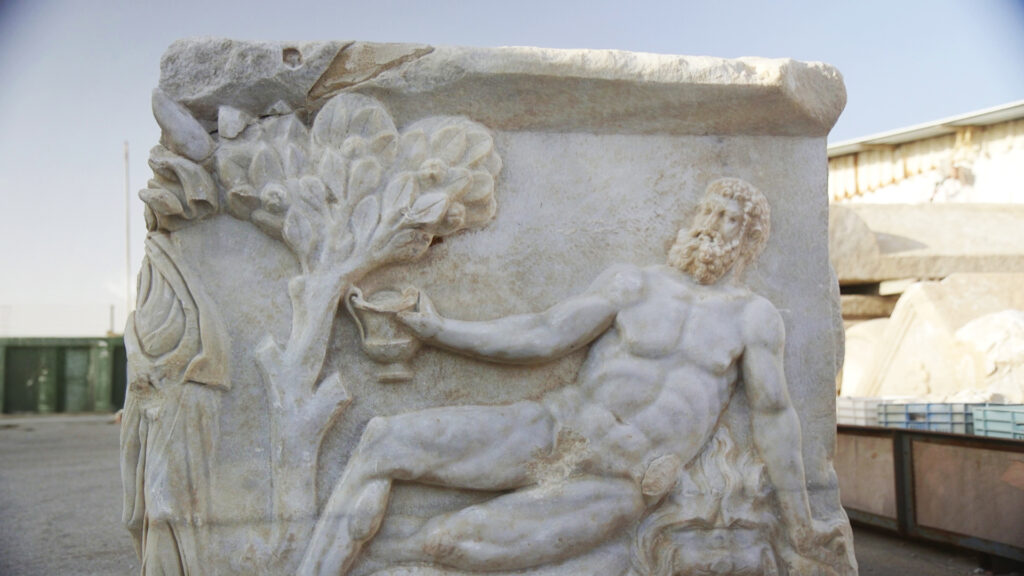
The side of the marble sarcophagus, depicting the scene of Hercules, sprawled on a lion’s skin and holding a cup in his hand. Photo: Emil Aladjem, Israel Antiquities Authority
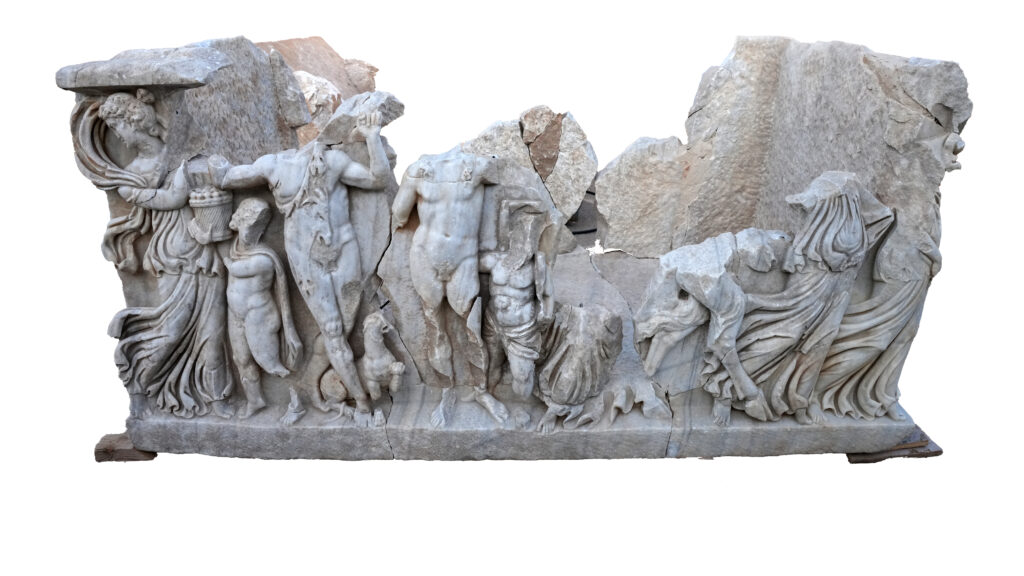
The marble sarcophagus after its preservation by the Conservation Department experts of the Israel Antiquities Authority. Photo: Shatil Emmanuilov, Israel Antiquities Authority.
The restored sarcophagus showcases a vibrant mythological scene centered around Dionysus, the Roman god of wine. Surrounding the central figure is an elaborate procession featuring a diverse cast of mythological characters, including Maenads (female followers of Dionysus), satyrs, Hermes, Pan, lions, and tigers. The intricate carving demonstrates the exceptional skill of Roman artisans from nearly two millennia ago.
A Unique Regional Discovery
The significance of this find extends beyond its artistic merit. “This is the very first time we find the Dionysus and Hercules wine competition scene on a burial coffin in our region,” explains Nohar Shahar. While Dionysian processions were common motifs on 2nd and 3rd century CE sarcophagi, this particular drinking contest scene represents something special for the archaeological record of the area.
“While processions of the wine god Dionysus are a familiar motif in 2nd and 3rd centuries CE sarcophagi, yet this particular drinking contest scene – a familiar Roman art motif, is known to us here primarily in mosaics – such as those discovered in Zippori and Antioch,” Shahar notes.
Symbolism of Death and Rebirth
The sarcophagus offers profound insights into Roman beliefs about death and the afterlife. Rather than viewing death as an end, the artwork suggests a more optimistic perspective. “In this case, it seems that the figures are not only celebrating – they are in fact accompanying the dead on his last journey, when drinking and dancing are transformed into a symbol of liberation and transition to life in the next world,” Shahar explains. “This sarcophagus offers an unusual perspective of the idea of death – not as an end, but as the beginning of a new path.”
The Winner of the Ancient Contest
The artistic depiction also provides a clear answer to the mythological question of who emerged victorious in the drinking contest. “Hercules’ condition, depicted on the sarcophagus as someone who is no longer able to stand, points to the obvious answer: Dionysus,” Shahar observes with scholarly humor.
Expanding Understanding of Ancient Caesarea
The discovery location has also provided new insights into the ancient city’s boundaries. “The sarcophagus was found within an area where archaeological remains were found outside the well-known walls of Caesarea,” Shahar adds. “This means that the space leading into it was much wider and thus richer in finds than we thought until now.”
This finding suggests that Caesarea’s ancient settlement extended further than previously understood, potentially opening new avenues for future archaeological exploration.
The city was founded between 22 and 10 BCE by Herod (37-4 BCE) as an urban center and harbor on the earlier site of Straton’s Tower. Caesarea was populated through the late Roman and Byzantine eras. Before 640 CE, Caesarea Maritima transitioned from a capital Byzantine city to a smaller early Islamic settlement from the mid-7th century onward. With the transition, usage of the harbor declined until it fell out of use during the late 7th century and was abandoned.
Caesarea, often called Caesarea Maritima to differentiate it from Caesarea Philippi, was an important port city in the first century AD and the site of numerous events in the book of Acts. Caesarea Maritima is located about 30 miles north of modern Tel Aviv on the Mediterranean coast. In ancient times, it boasted one of the world’s largest artificial harbors and was a center of Roman governance in the region. In the New Testament, it is mentioned only in the book of Acts.
Conservation and Public Access
According to Eli Escusido, Director of the Israel Antiquities Authority, the discovery offers valuable insights into ancient Roman culture and beliefs. “This is a thought-provoking discovery reflecting how life and faith were perceived in the Roman world,” he states. “The sarcophagus is undergoing a meticulous conservation process, which upon completion will enable it to be presented to the general public as part of our commitment to making the country’s past heritage accessible.”
Public Presentation
The remarkable discovery will be formally presented to the academic community and public on Thursday, June 12, 2025, during a lecture at “The Feast” conference. The event will be held at the Eretz Israel Museum in Tel Aviv, organized in collaboration with the Israel Antiquities Authority, Tel Aviv University, and Bar Ilan University. The conference will focus on the theme of feasting in ancient cultures, making this sarcophagus discovery particularly relevant to the scholarly discussion.
The public is invited to attend this presentation, offering an opportunity to learn more about this extraordinary find and its significance for understanding Roman burial practices and beliefs in the ancient Levant.
This discovery represents not just an archaeological triumph, but a window into the sophisticated artistic traditions and complex spiritual beliefs that characterized Roman society in ancient Caesarea nearly two millennia ago.




